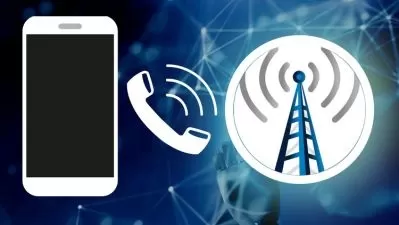Private 5G Networks / 5G Non-Public Networks (NPNs)
Dr. Moazzam Tiwana
1:52:15
Description
5G NPN Enablers, Spectrum & use cases, Deployment Models(SNPN, PNI-NPN), 5G-TSN Integration & Procedures in Industry 4.0
What You'll Learn?
- Private (Non-Public) 5G Networks & its examples
- Key Enables for Private 5G Networks
- Frequency Spectrum for Private 5G Networks
- Standalone Non-Public Network (SNPN)
- Public Network Integrated Non-Public Networks (PNI-NPNs)
- Shared RAN PNI-NPN
- Shared RAN and Control Plane PNI-NPN
- Hosted by the Public Network PNI-NPN
- Industry 4.0 & Time Sensitive Networking
- 5G System (5GS) Interworking with TSN
- Synchronization in TSN and 5G Networks
- 5G & TSN Interworking Procedures
- 5G Non-Public Networks (NPN)
Who is this for?
More details
DescriptionRecent years have seen a lot of increase in the adoption of private 5G networks, regulators are allocating more and more spectrum to the enterprises so that they can build their own private 5G networks. The fact that these networks they do not share traffic with public networks is a game changer for enterprises, as they can leverage the reliability, high-speed connectivity, low latency, security and power efficiency of 5G. This opens up new IoT possibilities and generates new revenue streams. A private 5G network can be thought of as a wireless local area network (LAN) that uses 5G-enabled technologies to create a network with dedicated bandwidth and infrastructure that meets a company's specific connectivity needs.
Private 5G networks can also be integrated with Time Sensitive Networking (TSN) for use in industry 4.0. So, future factories will be without cables and wires but can fulfill all requirements of time sensitive applications used in automation and control. Â
Course Contents:
Section 1: Introduction to Private 5G Networks
  What is a Private 5G Network?
  Why Private 5G Networks in a Factory?
  Why Private 5G Networks in Airports & Container Hubs etc?
  Why Private 5G Networks in Airports & Container Hubs etc?
  Key Requirements for Private 5G Networks
Section 2: Key Enablers for the Private 5G Networks
  Ultra Low Latency Features
  High Reliability Features
  QoS Customization in PDU Session
  5G Network Slicing
  Mobile Edge Computing (MEC)
  Massive MMO & Beamforming
Section 3: Frequency Spectrum for Private 5G Networks
  5G Frequency Bands
  Spectrum Types for Private 5G Networks
  Licensed Spectrum
  Shared Spectrum
  Channel Usage Co-ordination in Shared Spectrum
  Unlicensed Spectrum
  Unlicensed Spectrum Sharing Techniques
Section 4: Deployment Models For Private 5G/Non-Public Networks (NPNs)
  Introduction to Non-Public Networks (NPNs) Deployment Models
  Standalone Non-Public Network (SNPN)
  How a SNPN Registered UE can use Services of a Public Network
  Public Network Integrated Non-Public Networks (PNI-NPNs) and its Types
    1. Shared RAN PNI-NPN
    2. Shared RAN and Control Plane PNI-NPN
    3. Hosted by the Public Network PNI-NPN
  Closed Access Group (CAG) in PNI-NPNs
Section 5: Industry 4.0 & Time Sensitive Networking
   Introduction to Industry 4.0 & Time Sensitive Networking
   Time Sensitive Networking (TSN) for Deterministic Communication
   TSN Architecture and its Components
   Importance of Time Synchronization in TSN Networks
   Time Aware Scheduling in TSN Networks
   TSN Sample Workflow
Section 6: 5G System (5GS) Interworking with TSN
   Introduction to 5G System (5GS) Interworking with TSN
   TSN-Application Function (AF)
   Network Exposure Function (NEF)
   Session Management Function (SMF)
   Policy and Charging Function (PCF)
   Access & Mobility Management Function (AMF)
   Device Side TSN Translator (DS-TT) & Network Side TSN Translator (NW-TT)
   Characteristics of 5G System as TSN Bridge
Section 7: Synchronization in TSN and 5G Networks
   Introduction to Synchronization in TSN and 5G Networks
   Clock Flow in 5G Domain
   Clock Flow Between Two TSN Domains
   Calculation of Residence Time in 5G Bridge
Section 8: 5G & TSN Interworking Procedures
   5G & TSN Interworking Procedure Types
     1. 5G TSN Bridge Detection
     2. 5G TSN Bridge Informaion Reporting
     3. TSN Traffic Scheduling on a 5G TSN Bridge
   Time Sensitive Communication Time Synchronisation Function (TSCTSF)
Who this course is for:
- Anyone wanting to learn Private 5G Networks
- Telecom professional, 5G Enthusiast
Recent years have seen a lot of increase in the adoption of private 5G networks, regulators are allocating more and more spectrum to the enterprises so that they can build their own private 5G networks. The fact that these networks they do not share traffic with public networks is a game changer for enterprises, as they can leverage the reliability, high-speed connectivity, low latency, security and power efficiency of 5G. This opens up new IoT possibilities and generates new revenue streams. A private 5G network can be thought of as a wireless local area network (LAN) that uses 5G-enabled technologies to create a network with dedicated bandwidth and infrastructure that meets a company's specific connectivity needs.
Private 5G networks can also be integrated with Time Sensitive Networking (TSN) for use in industry 4.0. So, future factories will be without cables and wires but can fulfill all requirements of time sensitive applications used in automation and control. Â
Course Contents:
Section 1: Introduction to Private 5G Networks
  What is a Private 5G Network?
  Why Private 5G Networks in a Factory?
  Why Private 5G Networks in Airports & Container Hubs etc?
  Why Private 5G Networks in Airports & Container Hubs etc?
  Key Requirements for Private 5G Networks
Section 2: Key Enablers for the Private 5G Networks
  Ultra Low Latency Features
  High Reliability Features
  QoS Customization in PDU Session
  5G Network Slicing
  Mobile Edge Computing (MEC)
  Massive MMO & Beamforming
Section 3: Frequency Spectrum for Private 5G Networks
  5G Frequency Bands
  Spectrum Types for Private 5G Networks
  Licensed Spectrum
  Shared Spectrum
  Channel Usage Co-ordination in Shared Spectrum
  Unlicensed Spectrum
  Unlicensed Spectrum Sharing Techniques
Section 4: Deployment Models For Private 5G/Non-Public Networks (NPNs)
  Introduction to Non-Public Networks (NPNs) Deployment Models
  Standalone Non-Public Network (SNPN)
  How a SNPN Registered UE can use Services of a Public Network
  Public Network Integrated Non-Public Networks (PNI-NPNs) and its Types
    1. Shared RAN PNI-NPN
    2. Shared RAN and Control Plane PNI-NPN
    3. Hosted by the Public Network PNI-NPN
  Closed Access Group (CAG) in PNI-NPNs
Section 5: Industry 4.0 & Time Sensitive Networking
   Introduction to Industry 4.0 & Time Sensitive Networking
   Time Sensitive Networking (TSN) for Deterministic Communication
   TSN Architecture and its Components
   Importance of Time Synchronization in TSN Networks
   Time Aware Scheduling in TSN Networks
   TSN Sample Workflow
Section 6: 5G System (5GS) Interworking with TSN
   Introduction to 5G System (5GS) Interworking with TSN
   TSN-Application Function (AF)
   Network Exposure Function (NEF)
   Session Management Function (SMF)
   Policy and Charging Function (PCF)
   Access & Mobility Management Function (AMF)
   Device Side TSN Translator (DS-TT) & Network Side TSN Translator (NW-TT)
   Characteristics of 5G System as TSN Bridge
Section 7: Synchronization in TSN and 5G Networks
   Introduction to Synchronization in TSN and 5G Networks
   Clock Flow in 5G Domain
   Clock Flow Between Two TSN Domains
   Calculation of Residence Time in 5G Bridge
Section 8: 5G & TSN Interworking Procedures
   5G & TSN Interworking Procedure Types
     1. 5G TSN Bridge Detection
     2. 5G TSN Bridge Informaion Reporting
     3. TSN Traffic Scheduling on a 5G TSN Bridge
   Time Sensitive Communication Time Synchronisation Function (TSCTSF)
Who this course is for:
- Anyone wanting to learn Private 5G Networks
- Telecom professional, 5G Enthusiast
User Reviews
Rating
Dr. Moazzam Tiwana
Instructor's Courses
Udemy
View courses Udemy- language english
- Training sessions 49
- duration 1:52:15
- Release Date 2023/02/20











